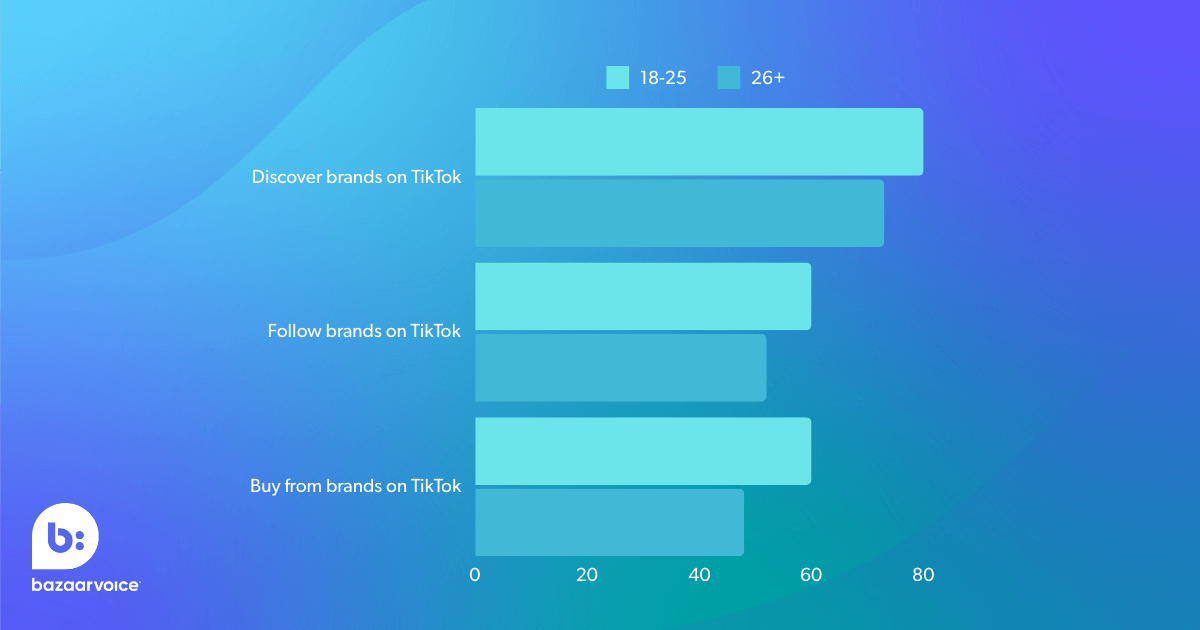May 3, 2024
Are you one of the millions of people who has viewed the #AerieREALpositivity video on TikTok — and possibly purchased Aerie clothing to take part in it? If yes, you’re definitely embodying the #TikTokMadeMeBuyIt trend — but also showcasing the content marketing power of community commerce.
Community commerce, or content commerce, refers to entertaining content on platforms like TikTok, that also happens to feature products and connects viewers to brands. Thousands of brands are already benefiting from community commerce and there’s plenty of room for yours to join that list.
TikTokkers spend about 3% of their month on TikTok(!), giving ample time to spontaneously discover new brands. And they’re not just discovering brands, they’re buying from them too.
Last year, consumers spent $6.2 billion on TikTok and it recently became only the 5th app to ever gross $10 billion revenue. So if you haven’t jumped on the community commerce trend, here’s an overview of what it is, and why you should incorporate it into your marketing strategy.
Chapters:
- What is community commerce?
- How to get started with community commerce
- Community commerce strategies
- Community commerce examples
- Win community commerce with social commerce
What is community commerce?
Community commerce is a type of word-of-mouth marketing driven by creators, characterized by entertaining, compelling content that features products or brands. Also referred to as content commerce, community commerce is embodied by the #TikTokMadeMeBuyIt hashtag, which has 7.5 million posts and literally billions of views at the time of writing.
A shopping journey that might have taken 19 days before now takes 19 seconds
Ajay Salpekar, Head of Beauty & Personal Care, TikTok Shop
It works like this. You open up TikTok and stumble upon something on your For You page, and you’re inspired by it. You realize this cool new product exists. So you buy it right there in the app. A shopping journey that might have taken 19 days before now takes 19 seconds! Hear Ajay Salpekar, Head of Beauty & Personal Care at TikTok Shop expand on this below.
Shopping has always been a social- and community-driven event. But it’s shifted from shopping with a handful of friends at the local mall to TikTok and other social media platforms with virtual communities, composed of billions of members.
Now creators — anyone with a phone and TikTok account! — are posting about your brand, adding hashtags, and tagging your products. And the key part is shoppers are discovering these products. 79% of users have discovered new brands through TikTok.
Through community commerce, you have a unique opportunity to build deeper connections with consumers by leveraging creators and their communities. You have a shot at authentically reaching a vast network of users looking for new things or discovering things they didn’t even know existed.
The rise of community commerce is rooted in the acceleration and widespread adoption of social commerce — the buying and selling of products on social media and everywhere social reaches. Social media has disrupted the purchase journey, which is now led by spontaneous discovery and inspiration, and no longer follows the traditional path.
How to get started with community commerce
During the recent Bazaarvoice Summit, Ajay Salpekar (reminder: Head of Beauty and Personal Care at TikTok Shop) talked about content commerce in the age of TikTok, where he outlined his recommendations for brands looking to join the community — whether enterprise level or a smaller team. Here’s his five main priorities for brands that see success:
- Be willing to experiment. In Ajay’s own words, when it comes to nailing shoppable content, “brands who have a learning mindset or a learner’s mindset tend to do better a lot faster.” By that he means you need to actually be open to testing and implementing new features and journey paths, and have an analytical mindset that can guide you on what’s working and what isn’t
- Relinquish control. One of the hardest aspects of getting started with community commerce is taking a step back and allowing creators to create in your name. Let creators create — they’re the experts after all! Besides, 67% of TikTokkers say they feel closer to brands that post humanized, unpolished content
- Partner up with a mix of creators. Creator content is the lifeblood of community commerce but every creator will suit different needs. The mega and celeb creators will have a massive reach for building brand awareness, but tend to see lower engagement. Whereas micro-influencers are fantastic at building authentic, relatable content for their niche audiences. To catch that full myriad of shoppers, work with a good mix of both
- Develop a holistic content plan. For the brand stewards out there, don’t stick to one content type. Build out your content supply chain with a mix of in-house, agency, and branded content. Don’t just assume one type will work best, use all of the above. And coming back to point #1 above, down the line you can use analytics to decide where to lean into more
- Don’t work in silos. The final point Ajay makes is an important one — media is still a brand’s greatest amplifier. Community commerce hasn’t changed that. The expertise of agency, brand, marketing, and e-commerce teams all apply but most teams still work in silos. In reality, brands see the most success in the content commerce world when they all partner together for shoppable content
Community commerce strategies
Social media continues to be a source of inspiration, where consumers learn about new products. The social media community drives product awareness, purchase consideration, and conversion. And it doesn’t just apply to younger generations like Gen Z either! A common misconception, as research shows.
So, it’s no longer enough for brands to simply have a social media presence. You need to engage with consumers, tell a story, and establish your brand as likable. That’s where community commerce comes in. Here’s how.
1. Put authenticity on display
Community commerce works best when brands and consumers share a sense of belonging and emotional connection. By blending community, entertainment, shopping, and brand messaging, you can inspire authentic but unique product discovery and influence purchases.
Authenticity is crucial in community commerce. Even the cool kids with sleek branding need to jump down a level or two. On Instagram, you may add highly stylized photos to attract attention, but that doesn’t work on TikTok.
Community commerce is about being real. It’s a chance for your brand to be its authentic self — whether that’s silly, playful, or vulnerable.
2. Entertainment drives action
On platforms like TikTok, users don’t want to be advertised to. Instead, they’re looking for unique experiences that are fun and entertaining! Whether it’s a game, funny dance, or a quirky contest or challenge, let your creativity run wild and jump on the latest trends.
Consumers want to discover new content that comes to life — and they don’t care if that content also contains products or showcases brands. That’s the beauty of community commerce content.
Remember when Ocean Spray, the 90-year-old brand, got a big boost after a viral TikTok video a few years back? It showed a man lip-syncing the Fleetwood Mac song “Dreams,” while riding a longboard and swigging the brand’s cranberry juice.
The more entertaining you are, the more authentic you are. Low-cost airline are well known for this and have amassed a massive following on TikTok with their funny vids.
@ryanair Is your friendship worth €8 #pascal #nicolascage #ryanair ♬ original sound – ghoulia
Their content gets people talking. And more buzz means higher awareness and product discovery, which translates to purchases and consumer engagement.
3. Tap into creator- and user-generated content
We’re in a a creator economy. With TikTok’s reach growing, the best way to reach these consumers is by partnering with creators and influencers who are already on the platform. Working with creators (NB: a mix of different types!) will drive awareness of your brand and help you come across as more relatable.
Let your everyday fans be your creators, too. Encouraging user-generated content (UGC), such as videos of consumers using your products, heightens the authenticity factor. Most consumers appreciate the chance to get creative and engage with their favorite brands.
Over half (53%) of shoppers identify themselves as UGC creators, according to our research, and 70% are happy to share their social content with brands when asked.
This approach will help you build new communities. Just encourage everyone to use hashtags related to your brand and product sector, like #beauty or #fashion. Community commerce content is quick to create. TikTok was designed to make content creation easy and expensive, and videos can be uploaded within minutes.
4. Make your content shoppable
All of the above is pretty superfluous if users can’t purchase directly through the app. Remember, as consumers are watching funny dance or outlandish challenge videos, they’re discovering new products and being inspired to purchase. 54% of TikTok users have purchased a brand after seeing it on the platform. That’s the spirit of community commerce and why #TikTokMadeMeBuyIt has billions of views. But they can’t do that if your content isn’t shoppable!
TikTok Shop, for example, lets brands link their Shopify product catalogs, which will show up in the Shopping tab on your profile. Other e-commerce platforms, like Square and OpenCart, will be on board soon. You can also add product links to videos that feature your items.
And link-in-bio solutions such as Like2Buy make all of your TikToks (and Instagrams!) shoppable without leaving the app.
5. Amplify your message beyond social
Social media shouldn’t be restricted to social! Towards the end of his Summit presentation, Ajay went on to explain that brands that do really well with media on TikTok are the ones that partner deeply with creators, and then very quickly turn on the taps for their media spend to amplify the messages that work well for the brand.
That means syndicating your creator content to everywhere else your shoppers are. Think product pages, emails, paid ads, and even in-store! Getting your content in front of shoppers everywhere they are means purchases can happen anywhere, anytime, instantly. Your bottom line will thank you for it.
Community commerce examples
Brands are tapping into community commerce, energizing their customers, and driving sales in the process. Here’s three examples of community commerce in action.
Benefit Cosmetics
Benefit Cosmetics is a global beauty brand that decided to partner with TikTok Shop for their launch of Fan Fest Mascara, which was their biggest launch of the year. It was an exclusive launch with TikTok Shop, and they were the first brand to go live for 24 hours.
@gabriella__andrea @Benefit Cosmetics Fan Fest Mascara 9/10✨🫶🏻 • @Charlotte Tilbury magic cream & setting spray @loréal paris usa lumi glotion @Estée Lauder double wear foundation @tarte cosmetics sculpt tape & pressed powder deep tan (its broken lol) @e.l.f. Cosmetics @elfcosmetics monochromatic blush stick & lip stain @Milani berry amore blush & lip oil @maccosmetics @maccosmeticsusa stufio fix pressed powder @Laura Mercier loose setting powder @NYX Professional Makeup brow pencil @L.A. Girl Cosmetics lip liner @Too Faced an ancient highlight, bronze, blush palette im obsessed with! @Gisou hair oil @Gucci bloom perfume • #grwm #trending #gucci #guccibloom #makeuphacks #benefit #benefitcosmetics #fanfest #fanfestmascara #benefitfanfestmascara #benefitfanfest ♬ hits different speed up – elly
Since launch, they’ve had over 500 videos made featuring Fan Fest, with upwards of 63 million views. But more importantly, sales of the Fan Fest Mascara even outpaced their own e-commerce site with 48,000 units sold.
Maybelline
In an effort to boost its brand image and emotional connection with Gen Z shoppers, Maybelline worked with TikTok beauty creator @jessica.eid_ and others to promote its Lash Sensational Sky HIgh Mascara and other products. The overall campaign brought in:
- 20 million impressions
- 553,000 engagements
- 20% increase in sales
Not only that, but the mascara went viral, with a 49% increase in sales during the week of the promotion and a 190% increase month-over-month. The mascara also sold out on Ulta Beauty’s website four times over.
American Eagle
Apparel brand American Eagle partnered with TikTok star Addison Rae on the #InMyAEJeans back-to-school branded hashtag challenge in 2020. The campaign asked TikTok users to make a video with American Eagle’s song while wearing their favorite jeans from the brand.
Using the hashtag #InMyAEJeans for a chance to be featured in a duet with Rae. After the campaign, American Eagle had:
- 432,000 TikTokkers making 800,000 videos
- 7 billion views for the campaign
In another campaign, American Eagle’s Aerie line saw its OFFLINE crossover leggings sell out multiple times after TikTok influencer @hannahschlenker posted a video about them to her more than 800,000 followers. The video went viral, attracting nearly 900,000 likes.
Win community commerce with social commerce
Social media offers the potential to reach billions of people and an infinite number of communities. Engaging these consumers depends on creating fun, entertaining content that shows off your products in an authentic, meaningful way.
Brands are already demonstrating the benefits of community commerce on TikTok. These strategies can help you kickstart your own community commerce strategy — so that you can foster emotional connections with shoppers that inspire them to get to know your brand and make a purchase or two.
And that’s only the beginning. Want to turn social content into shoppable experiences that drive sales wherever shoppers are? Read The ultimate guide to social commerce conversion to discover how.












